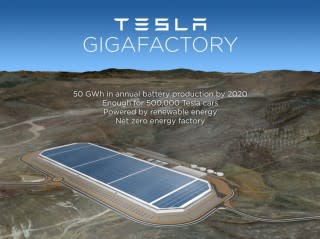As reported by Yahoo Autos: The very word "gigafactory" makes Tesla Motors' lithium-ion cell fabrication and battery assembly plant sound quite large.
Brought to us via the Transport Evolved website, the video was taken not from an airplane but by a remote-controlled drone.

But how huge it actually is can be hard to comprehend.
Context is provided by diagrams that compare its planned footprint to, say, the largest building for assembling jetliners on Boeing's Washington state campus.
So a new video may help add perspective. Shot just this week, it shows flyover footage of the factory under construction in northern Nevada.
 |
| Tesla Motors gigafactory - size comparisons [source: EV Obsession] |
Accompanied by somber music, the 2-minute clip shows the rectangular two-story factory building from a number of angles.
The building appears to have the second-story roof largely completed.
According to the YouTube page, it was posted by a user named "Quick Laptop Cash" (ahem). It's described as follows:
The first 4k ultra-high-definition video of the Tesla Gigafactory. Located 15 minutes east of Reno, Nevada, the Gigafactory is growing at a steady pace and helping fuel the strong economic recovery in Northern Nevada.
The description continues as follows:
To ensure safety this video was recorded while no workers were present and from over 1 mile away with a DJI Phantom 3 Professional Drone utilizing GPS. The drone was in constant visual contact as well as maintaining an altitude of not more than 400 feet above ground level.

Rendering of Tesla battery gigafactory outside Reno, Nevada, Sep 2014
The YouTube page is followed by a promotional link to a site that purports to inform about and list homes in the Reno, Tahoe, and Sparks areas of Nevada.
Interstingly, it appears to have been created and posted by local boosters grateful for the jobs and opportunity the huge plant is expected to provide.
When completed, the gigafactory will provide batteries not only for the Tesla Model 3 electric car expected to launch in 2017 or 2018, but also the Tesla Powerwall home energy-storage battery and similar products intended for commercial and industrial use.
The video ends with a note of thanks to many parties: Tesla CEO Elon Musk, Tesla itself, Nevada governor Brian Sandoval, the construction workers building the factory, EDAWN, and Nevada lawmakers.
"You are creating jobs and helping to redefine our once-struggling local economy" by building the $5 billion gigafactory, it says in closing.






















